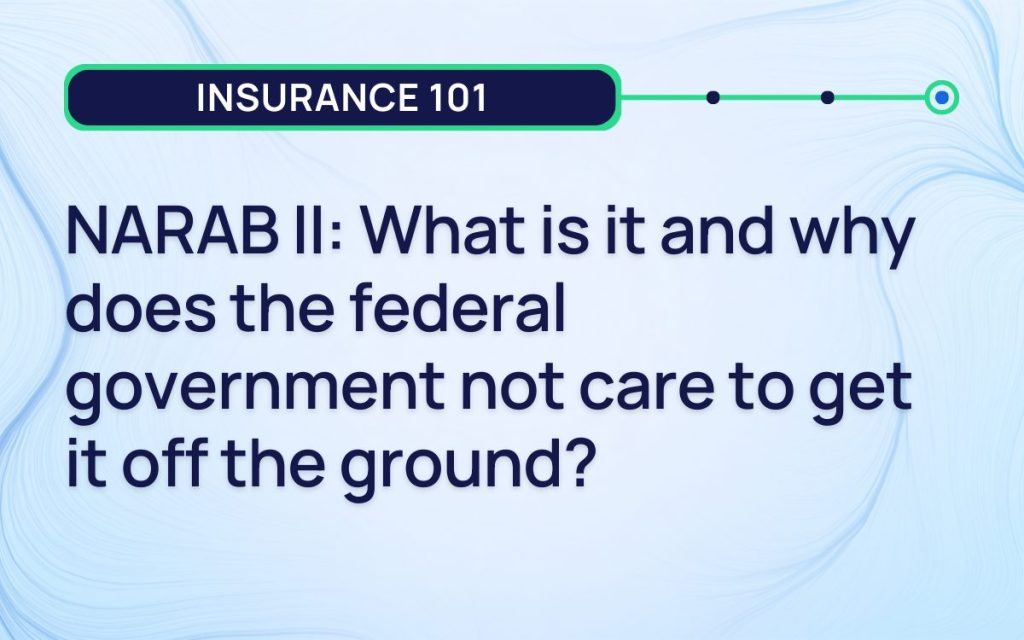NARAB II: What is it and why does the federal government not care to get it off the ground?

Exploring the lack of progress surrounding the National Association of Registered Agents And Brokers Reform Act of 2015
On Jan. 12, 2015, the National Asociation of Registered Agents and Brokers Reform Act of 2015, or NARAB II for those who don’t have all day, was enacted as part of the Terrorism Risk Insurance Program Reauthorization Act of 2015 (TRIA). NARAB II represented a significant step in simplifying insurance producer licensing in these here United States, so when President Obama signed it into legislation, insurance professionals and consumers across the nation held their breath in anticipation.
Only for nearly a decade to pass with no notable progress.
Today, we’re exploring the question on everyone’s mind: What ever happened to NARAB II?
NARAB II implies the existence of NARAB I
Before we crack the code on the mysterious disappearance of NARAB II, let’s get more familiar with its first iteration. NARAB I, better known just as NARAB, can be traced all the way back to a provision in the federal Gramm-Leach-Biley Act of 1999 (GLBA). The provision called for the creation of a new organization (aka NARAB) if the states couldn’t achieve greater producer-licensing uniformity or reciprocity by November of 2002.
In a not-so-shocking turn of events, the states weren’t thrilled by the thought of federal interference in the way they operate. So, faced with the possibility of NARAB, state regulators and the National Association of Insurance Commissioners (NAIC) chose to work toward reciprocity and adopted the Producer Licensing Model Act in 2000. As a result, the GLBA’s version of NARAB was no more.
What happened between NARAB and NARAB II?
A whole lot. But to recount every insurance regulation change, revision, or update in the years between 1999 and 2015 would be impossible. Just look at how much happens in a month. Instead, here’s a little context-building history on state reciprocity progress in the years between NARAB and NARAB II.
The 2007 Producer Licensing Assessment
Seven years after adopting the Producer Licensing Model Act, the NAIC conducted a national producer-licensing assessment to evaluate compliance with the reciprocity and uniformity provisions of GLBA. They found that all 35 states that met the GLBA’s reciprocity requirements and thus negated the creation of NARAB remained in compliance and that additional states were now eligible for certification.
The 2009 updates to reciprocity criteria
Not long after the producer licensing assessment, the NAIC updated the reciprocity criteria to include a more detailed analysis of the original standards along with additional issues not included in the original report. By October 2011, the NAIC’s NARAB (EX) Working Group found 40 jurisdictions to be eligible for reciprocity certification.
All in all, things were looking pretty good concerning state reciprocity.
So, why NARAB II?
There’s no doubt that some progress has been made since NARAB’s founding to improve the uniformity of producer licensing across the states. But, by 2015, several large states still weren’t reciprocal, making it more difficult for insurance producers to obtain nonresident licenses in all of the states.
This difficulty led to renewed calls for NARAB and, in 2015, a modified version of NARAB creatively titled NARAB II was enacted and President Obama signed it into legislation. Overall, the purpose of NARAB II remains largely the same as its predecessor: to streamline the U.S. nonresident insurance producer licensing process, allowing producers licensed in their home state to sell in each state they intend to do business in, as long as they’re licensed for those lines of business in their home state and they pay the state’s licensing fee.
While producer licensing might still be as expensive, NARAB II would at least alleviate some of the expense for firm-level producers by nullifying their need to register with the secretary of state and pay corporate fees in each state.
How does NARAB II work?
NARAB II establishes the independent nonprofit corporation, NARAB, which is controlled by a board of directors. The 13-member board includes eight current or former state insurance commissioners along with five insurance industry representatives. The main responsibility of the board is to adopt licensing, continuing education, and other nonresident producer requirements and conditions on a multi-state basis.
In a 2015 press release, The Independent Insurance Agents and Brokers of Americea (Big I) stated that NARAB II would “build upon regulatory experience at the state level, promote greater consistency in non-resident agent and agency licensing, ease the burden that many agents face in doing business across state lines, and increase consumer choice.”
And now here we are in 2023 asking: What happened to NARAB II?
What happened to NARAB II?
As you may recall, NARAB II legislation required the president to appoint a 13-member board of directors. Once the Senate confirmed those members, NARAB would be off and running. While President Obama did end up nominating 10 individuals, nominations were slow and never reached the required 13. Furthermore, the Senate never confirmed any of the nominees and before long the Trump Administration took over.
NARAB II progress during the Trump Administration
Apparently, resubmitting the Obama Administration’s nominees or nominating different candidates wasn’t high on the 45th President’s list of priorities because, three years after he took office, no progress had been made. In April of 2019, Congressman Barry Loudermilk sent the President a bipartisan and bicameral letter touting the importance of NARAB II and (respectfully) requesting the administration proceed with the nomination process as soon as possible so NARAB could begin its operations.
Crickets.
NARAB II progress during the Biden Administration
When no answer came from the Trump Administration, NARAB II supporters turned to their next hope, the Biden Administration. In May of 2023, another letter, this time coined by several notable insurance and financial organizations, including the American Property Casualty Insurance Association, the Council of Insurance Agents and Brokers, and the National Association of Insurance and Financial Advisors, urged the President to act on the matter as soon as possible.
As of October 2023, no answer.
Will 2024 spell positive momentum for NARAB II?
Only time will tell, but at the rate things are moving, we aren’t holding our breath.
In the meantime, we’re focusing on actions we can take now to ease insurance producer burdens, like simplifying onboarding processes and compliance. If you’re a carrier, agency, or MGA/MGU looking for a way to improve the producer experience that won’t take over a decade, AgentSync can help. Talk to one of our experts today.

